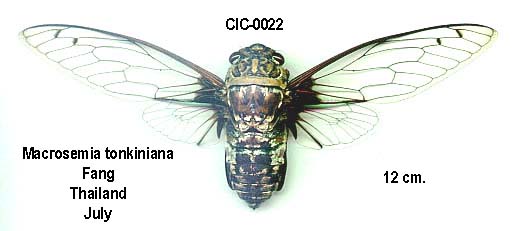Pomponia linearis is a cicada found in India.
Photo by Raghu Ananth taken in Bhagamandala, Coorg, India:

Scientific classification:
Family: Cicadidae
Subfamily: Cicadinae
Tribe: Cicadini
SubTribe: Psithyristriina
Genus: Pomponia
Species: Pomponia linearis (Walker, 1850)
For more information about this cicada, visit Cicadas of India.
Yasumasa Saisho of the Cicadae in Japan website left a note on Facebook about this cicada:
Pomponia linearis is currently considered to contain several species (complex), for example, the population of Taiwan and Japan has been changed to Pomponia yayeyamana. See Duffels and Hayashi (2006) Tijd. Entomol., 149, 189-201.
I’m putting this at the end. It is a description of Pomponia fusca which back in the 1800s was a “synonym” of Pomponia linearis, from A Monograph of Oriental Cicadas by W. L. Distant. 1889-1892. Read it on the Biodiversity Heritage Library website:
Head, pronotum, and mesonotum are greenish-ochraceous. Head with the anterior margins of the front, an irregular central fascia to vertex enclosing the ocelli, a large spot on the inner side of eyes, and the anterior lateral angle of vertex, dark olivaceous. Pronotum with a broad central longitudinal fascia, two large oblique spots on each lateral area, and a spot on the lateral margin, brownish-olivaceous. Mesonotum with seven brownish-olivaceous spots; situate two central and obconical, between which is an arrow-shaped discal spot, a small spot on each side of the two central ones, and a long spot on each lateral area, two small spots of the same color in front of each anterior angle of the basal cruciform elevation. Abdomen pale castaneous with ochraceous pilosity. Head beneath, sternum, legs, and opercula pale greenish ; upper and apical areas of face, a spot between face and eyes, posterior margins of eyes, anterior tibiae, apices of intermediate tibiae, a spot near apices of femora, apices of anterior and intermediate tarsi, apex of rostrum, and a triangular spot between the intermediate and posterior coxae, dark fuscous. Abdomen beneath dark ochraceous.
Tegmina and wings pale hyaline ; tegmina with the costal membrane greenish, transverse veins at the bases of the second, third, fourth, fifth, seventh and eighth apical areas infuscated, and a marginal series of small fuscous spots situate at the apices of the longitudinal veins to apical areas; the venation is otherwise ochraceous, sometimes replaced by black; basal cell and claval margin brownish-ochraceous.
Wings with the venation brownish-ochraceous; claval margin darker in hue.
Long. excl. tegm.












